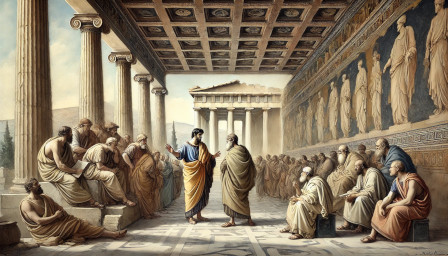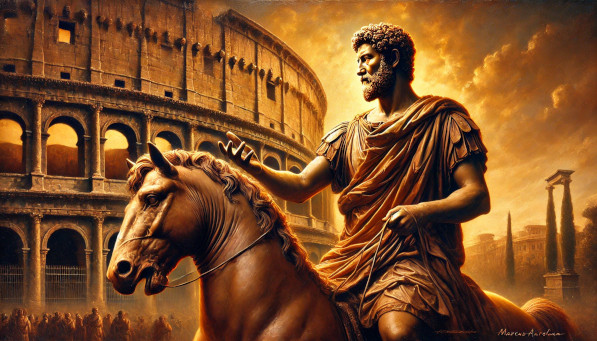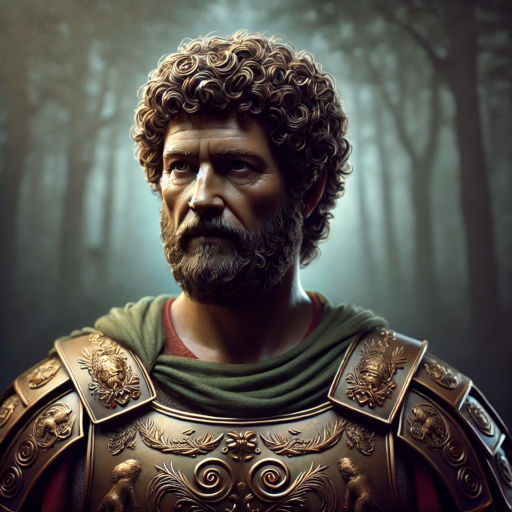A Brief History of Stoicism
Stoicism, one of the most enduring philosophical traditions, originated in Athens around 300 BCE. Its foundational ideas, shaped by the struggles and reflections of its founder, Zeno of Citium, have influenced countless thinkers and leaders throughout history. To fully appreciate Stoicism, we must trace its journey from its origins in ancient Greece, through its flourishing during Roman times, its decline during the Middle Ages, and its remarkable rediscovery and renaissance in modern times.
The Origins of Stoicism
Zeno of Citium: From Shipwreck to Philosopher
The philosopher Zeno, widely credited as the founder of Stoicism, was born in Citium, a Greek-speaking city on the island of Cyprus, around 334 BCE. His life took a dramatic turn when a shipwreck caused him to lose his wealth, leaving him stranded and destitute. Seeking a new path, Zeno arrived in Athens and found solace in philosophy. While reading about Socrates in a bookshop, he famously asked the bookseller, “Where can I find a man like this?” The bookseller directed him to Crates of Thebes, a prominent Cynic philosopher, who became Zeno’s first mentor and introduced him to the principles of living a virtuous and disciplined life.
Crates’ austere teachings emphasized living in harmony with nature, rejecting material excess, and focusing on virtue. While Zeno admired these ideas, he sought a more systematic and practical approach to philosophy. Over time, he began synthesizing ideas from earlier traditions, including the Cynics, the Socratic method, and the teachings of Heraclitus, who emphasized the rational order of the universe.

Zeno began teaching his philosophy at the Stoa Poikile (Painted Porch), a colonnade in Athens adorned with vivid murals. This location gave Stoicism its name, as “Stoa” means “porch” in Greek. Since Zeno and his disciples regularly gathered and taught at the Stoa Poikile, they came to be known as the Stoics.
Zeno’s teachings revolved around the idea that a good life is achieved by living in accordance with nature and reason, cultivating virtues such as wisdom, courage, justice, and temperance.
Cleanthes and Chrysippus
After Zeno’s death, his student Cleanthes succeeded him as the head of the Stoic school. Cleanthes, originally a wrestler from Assos in Asia Minor, turned to philosophy later in life and studied under Zeno while supporting himself by working as a water carrier. Cleanthes expanded on Zeno’s teachings, and emphased the role of divine reason in the universe, which he viewed as the rational principle governing all existence. While most of his writings have been lost, his contributions laid the groundwork for the next leader of the school, Chrysippus.
Chrysippus, often called the “second founder of Stoicism,” was born in Soli, a city in Cilicia (modern-day Turkey), around 279 BCE. Originally trained as a long-distance runner, he later devoted himself to philosophy, studying under Cleanthes in Athens. Chrysippus was a prolific writer, reportedly authoring over 700 works. He refined Stoic logic, ethics, and physics, creating a comprehensive framework for the philosophy and solidifying its doctrines.
The Roman Flourishing of Stoicism
While Stoicism originated in Greece, it reached its zenith in Rome, where it became deeply integrated into Roman culture and was immensely popular during ancient times. In a world plagued by misfortunes, wars, pestilence, and constant challenges Stoicism offered practical tools to help individuals navigate the hardships and uncertainties of daily life.
Its focus on ethics, resilience, and living virtuously made it profoundly appealing to people from all walks of life, including soldiers, statesmen, and emperors.
Stoicism became one of the most dominant schools of thought in the ancient world. During the Roman Empire, it was elevated to its greatest heights by figures such as Seneca, Epictetus, and Marcus Aurelius, who firmly established it as a cornerstone of philosophical and ethical thought.
Epictetus: The Slave Turned Philosopher
Epictetus was Greek. He was born into slavery in Hierapolis (modern-day Turkey) and was eventually brought to Rome by his owner, Epaphroditus, who was a wealthy and influential freedman in Emperor Nero’s court. While in Rome, Epictetus began studying philosophy under the renowned Stoic teacher Musonius Rufus, who significantly shaped his intellectual development.

After gaining his freedom, Epictetus established his own school, where he emphasized that true freedom lies not in external circumstances but in mastering one’s mind and aligning oneself with the natural order of the universe. His teachings, as recorded by his student Arrian in the Discourses and the Enchiridion (Handbook), have profoundly influenced Stoicism and philosophical thought.
Epictetus lived and taught in Rome until 89 CE, when Emperor Domitian expelled philosophers from the city. Following this exile, Epictetus moved to Nicopolis, in Epirus (modern-day Greece), where he established his own school of philosophy.
A key concept in Epictetus’ philosophy is the dichotomy of control: the understanding that we should focus only on what is within our control (our thoughts, actions, and reactions) and accept what is beyond our control (external events and outcomes).
Seneca: The Statesman and Playwright
Lucius Annaeus Seneca, a Roman statesman, playwright, teacher and advisor to Emperor Nero, exemplified the practical application of Stoic philosophy in the complexities of political life. Seneca’s writings, including Letters to Lucilius and On the Shortness of Life, offer profound reflections on time, mortality, and the pursuit of virtue.
Marcus Aurelius: The Philosopher King
Perhaps the most iconic Stoic figure, Marcus Aurelius was a Roman emperor who ruled with wisdom and restraint during a time of immense turmoil. His personal journal, Meditations, offers a rare glimpse into the mind of a ruler striving to live virtuously while grappling with the burdens of power.

Stoicism and Christianity
Stoicism significantly influenced Christianity or, at the very least, helped pave the way for its adoption in the Roman world. Its ethical teachings and emphasis on self-discipline resonated with early Christian thought. The Stoic idea of a rational principle that governs and organizes the universe closely parallels the Christian concept of divine order and the Word of God as described in the Gospels, providing a philosophical foundation that facilitated the integration of Christian theology into the Roman intellectual tradition.
Many of the virtues championed by Stoicism, such as temperance, justice, and self-control, naturally aligned with Christian values. Early Christian writers like Clement of Alexandria and Saint Augustine drew heavily from Stoic philosophy to articulate their theological ideas. Another notable example is Athenagoras of Athens, who, originally a Greek philosopher, became one of the early Christian apologists. He emphasized reason, divine order, and ethical living—ideas deeply resonant with Stoic principles.
The Stoic emphasis on enduring suffering with dignity and focusing on the inner self influenced Christian martyrdom and the concept of finding divine meaning in hardship. While the two philosophies differed on metaphysical points, such as the nature of God and the afterlife, their ethical commonalities bridged the gap between pagan and Christian traditions.
However, with the rise of Christianity in the Roman Empire, Stoicism began to lose favor. Christianity offered a more personal and relational approach to the divine, focusing on salvation and an afterlife, which contrasted with the impersonal Stoic God
As Christian theology became the dominant intellectual framework of the late Roman Empire, Stoicism faded into the background. By the Middle Ages, it was largely overshadowed, though some of its ideas persisted subtly within Christian ethics and monastic practices.
The Resurgence of Stoicism in Modern Times
In recent years, Stoicism has experienced a remarkable revival. Modern thinkers and writers like Ryan Holiday (The Daily Stoic) and Donald Robertson (How to Think Like a Roman Emperor) have brought Stoic principles to a contemporary audience.
This resurgence is fueled by Stoicism’s practical relevance to modern challenges, including stress, anxiety, and the complexities of modern life. Its focus on rationality, resilience, and personal responsibility aligns well with the demands of a fast-paced world.
The philosophy has found particular appeal in the self-help movement, leadership training, and even therapy, as elements of Stoic thought underpin Cognitive Behavioral Therapy (CBT).
Conclusion
From its origins in Zeno’s teachings at the Painted Porch to its influence on Christianity and its resurgence in modern times, Stoicism’s journey reflects its timeless relevance.




